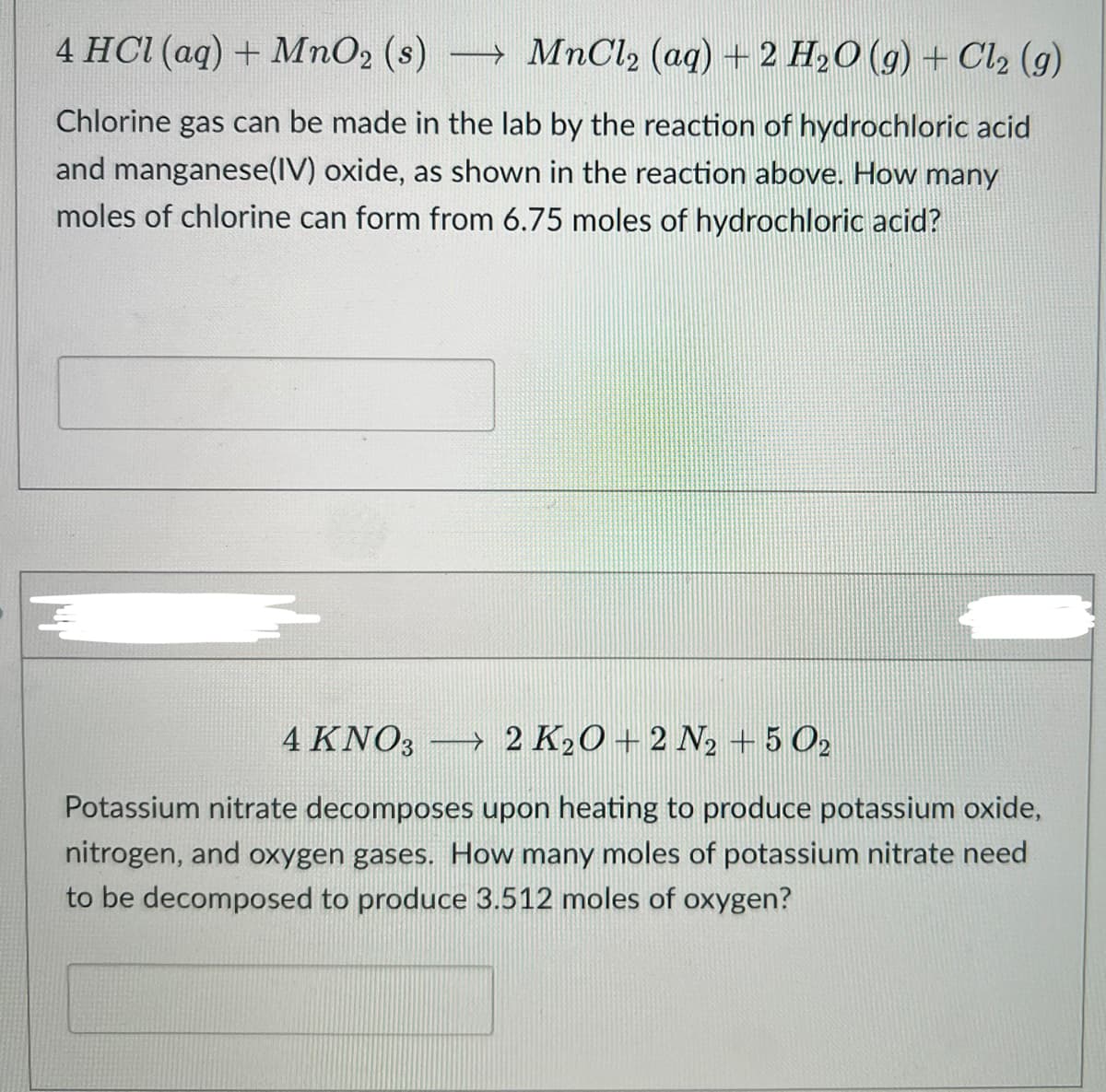4 HCI (aq) + MnO2 (s) → MnCl2 (aq) + 2 H,O (g) + Cl, (g) Chlorine gas can be made in the lab by the reaction of hydrochloric acid and manganese(IV) oxide, as shown in the reaction above. How many moles of chlorine can form from 6.75 moles of hydrochloric acid? 4 KNO3 → 2 K20 + 2 N2 + 5 O2 Potassium nitrate decomposes upon heating to produce potassium oxide, nitrogen, and oxygen gases. How many moles of potassium nitrate need to be decomposed to produce 3.512 moles of oxygen?
4 HCI (aq) + MnO2 (s) → MnCl2 (aq) + 2 H,O (g) + Cl, (g) Chlorine gas can be made in the lab by the reaction of hydrochloric acid and manganese(IV) oxide, as shown in the reaction above. How many moles of chlorine can form from 6.75 moles of hydrochloric acid? 4 KNO3 → 2 K20 + 2 N2 + 5 O2 Potassium nitrate decomposes upon heating to produce potassium oxide, nitrogen, and oxygen gases. How many moles of potassium nitrate need to be decomposed to produce 3.512 moles of oxygen?
Chemistry: Principles and Practice
3rd Edition
ISBN:9780534420123
Author:Daniel L. Reger, Scott R. Goode, David W. Ball, Edward Mercer
Publisher:Daniel L. Reger, Scott R. Goode, David W. Ball, Edward Mercer
Chapter3: Equation, The Mole, And Chemical Formulas
Section: Chapter Questions
Problem 3.49QE:
One of the ways to remove nitrogen monoxide gas, a serious source of air pollution, from smokestack...
Related questions
Question

Transcribed Image Text:4 HCI (aq) + MnO2 (s) → MnCl2 (aq) + 2 H,O (g) + Cl, (g)
Chlorine gas can be made in the lab by the reaction of hydrochloric acid
and manganese(IV) oxide, as shown in the reaction above. How many
moles of chlorine can form from 6.75 moles of hydrochloric acid?
4 KNO3 2 K20 +2 N2 + 5 O2
Potassium nitrate decomposes upon heating to produce potassium oxide,
nitrogen, and oxygen gases. How many moles of potassium nitrate need
to be decomposed to produce 3.512 moles of oxygen?
Expert Solution
This question has been solved!
Explore an expertly crafted, step-by-step solution for a thorough understanding of key concepts.
This is a popular solution!
Trending now
This is a popular solution!
Step by step
Solved in 3 steps with 2 images

Knowledge Booster
Learn more about
Need a deep-dive on the concept behind this application? Look no further. Learn more about this topic, chemistry and related others by exploring similar questions and additional content below.Recommended textbooks for you

Chemistry: Principles and Practice
Chemistry
ISBN:
9780534420123
Author:
Daniel L. Reger, Scott R. Goode, David W. Ball, Edward Mercer
Publisher:
Cengage Learning

Chemistry: An Atoms First Approach
Chemistry
ISBN:
9781305079243
Author:
Steven S. Zumdahl, Susan A. Zumdahl
Publisher:
Cengage Learning

Chemistry for Engineering Students
Chemistry
ISBN:
9781337398909
Author:
Lawrence S. Brown, Tom Holme
Publisher:
Cengage Learning

Chemistry: Principles and Practice
Chemistry
ISBN:
9780534420123
Author:
Daniel L. Reger, Scott R. Goode, David W. Ball, Edward Mercer
Publisher:
Cengage Learning

Chemistry: An Atoms First Approach
Chemistry
ISBN:
9781305079243
Author:
Steven S. Zumdahl, Susan A. Zumdahl
Publisher:
Cengage Learning

Chemistry for Engineering Students
Chemistry
ISBN:
9781337398909
Author:
Lawrence S. Brown, Tom Holme
Publisher:
Cengage Learning

Chemistry: Principles and Reactions
Chemistry
ISBN:
9781305079373
Author:
William L. Masterton, Cecile N. Hurley
Publisher:
Cengage Learning

Chemistry by OpenStax (2015-05-04)
Chemistry
ISBN:
9781938168390
Author:
Klaus Theopold, Richard H Langley, Paul Flowers, William R. Robinson, Mark Blaser
Publisher:
OpenStax

Chemistry: The Molecular Science
Chemistry
ISBN:
9781285199047
Author:
John W. Moore, Conrad L. Stanitski
Publisher:
Cengage Learning